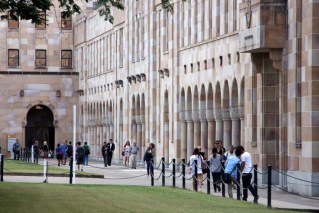Aussie virus expert tells of ‘tense’ investigation of Chinese origins
An Australian expert on the international team probing the origins of the coronavirus says the investigation was at times very tense, flagging concerns about access to early case data.

Australian doctor Dominic Dwyer of the World Health Organization team arrives for a field visit at the Service Center for Party Members and Residents of Jiangxinyuan Community in Wuhan in central China's Hubei province. (AP Photo/Ng Han Guan)
Sydney virologist Professor Dominic Dwyer has returned to Australia after spending nearly a month in China as part of the World Health Organisation-led team seeking to understand how the virus started.
The team has been unable to find exactly how it transmitted to humans.
Dwyer credited Chinese experts for doing a great deal of work WHO had requested before the team arrived, including reviewing 76,000 case reports from 230 or so facilities in Wuhan to try and find early cases.
“When we got to the face-to-face meetings there was a lot of pressure,” he told ABC radio on Thursday.
Some meetings lasted up to 15 hours, with Chinese foreign affairs officials and language barriers intensifying the situation.
“It was actually very complicated and very tense,” he said.
Dwyer is “reasonably satisfied” about the level of access to information afforded to the team.
“Of course you can never be sure of stuff you’re not given. So that’s potentially a problem,” he said.
But Dwyer said there was tension over getting individual data on early cases for the WHO team to comb through, rather than be told the overall results.
“It was sometimes difficult to understand how they came to certain conclusions, and there were differences of opinion over that.”
Dwyer says the unclear findings show how complex the situation is, pointing to origin investigations of other diseases taking more than a year to solve.
“If the answer was easy there would be no reason for us to go, but the answers are difficult,” he said.
The WHO team has dismissed suggestions the pandemic was sparked by a lab leak in Wuhan.
It determined the virus was most likely to have been transmitted through an animal, but exactly which animal remains unclear.
Scientists found no clear link to bats, pangolins or any other wild animals.
The delegation also found the virus may have been spread through frozen food, and could have been active in other regions or countries before the first cases emerged in Wuhan.












